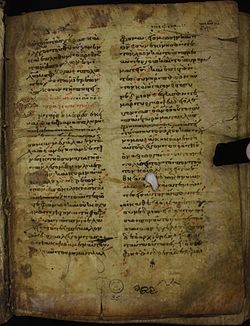Lectionary 170
| New Testament manuscript | |
 Folio 4 recto | |
| Text | Apostolarion |
|---|---|
| Date | 14th century |
| Script | Greek |
| Now at | Ann Arbor, Michigan |
| Size | 26.4 cm by 19.7 cm |
| Hand | ill written |
Lectionary 170, designated by siglum ℓ 170 (in the Gregory-Aland numbering) is a Greek manuscript of the New Testament, on parchment leaves. Palaeographically it has been assigned to the 14th century.[1] Scrivener dated it to the 12th or 13th century.[2] Formerly it was labelled as Lectionary 68a.[3] Scrivener by 65a.[2]
Description
The codex contains lessons from the Acts and Epistles lectionary (Apostolarion), on 160 parchment leaves (26.4 cm by 19.7 cm), with lacunae at the beginning and end.[3] The text is written in Greek minuscule letters, in two columns per page, 28-29 lines per page.[1] It is ill written.[4] It contains musical notes in red.[2]
The text reaches from the second Sunday after Easter, through the Ascension, Pentecost, to the sixteenth week after Pentecost. The Menology (folios 114 v – 160) has almost no lessons given at length, but overflows with rubrical directions.[4]
History
The manuscript was purchased in 1870 by Angela Burdett-Coutts. Formerly it was held in Burdett-Coutts III. 24 in London.[3]
The manuscript was examined by C. R. Gregory, who saw it in 1883.[3]
The manuscript is not cited in the critical editions of the Greek New Testament UBS3,[5] but it was cited in UBS4.[6]
It was digitised by the CSNTM.
Since 1922 the codex is located in the University of Michigan (Ms. 35) at Ann Arbor.[1]
See also
Notes and references
- ^ a b c Aland, Kurt; M. Welte; B. Köster; K. Junack (1994). Kurzgefasste Liste der griechischen Handschriften des Neues Testaments. Berlin, New York: Walter de Gruyter. p. 228. ISBN 3-11-011986-2.
- ^ a b c Scrivener, Frederick Henry Ambrose; Edward Miller (1894). A Plain Introduction to the Criticism of the New Testament. Vol. 1 (4th ed.). London: George Bell & Sons. p. 370.
- ^ a b c d Gregory, Caspar René (1900). Textkritik des Neuen Testaments. Vol. 1. Leipzig: J.C. Hinrichs. p. 468.
- ^ a b Adversaria Critica Sacra: With a Short Explanatory Introduction (Cambridge, 1893), p. LXXXIX.
- ^ The Greek New Testament, ed. K. Aland, A. Black, C. M. Martini, B. M. Metzger, and A. Wikgren, in cooperation with INTF, United Bible Societies, 3rd edition, (Stuttgart 1983), pp. XXVIII, XXX.
- ^ The Greek New Testament, ed. B. Aland, K. Aland, J. Karavidopoulos, C. M. Martini, and B. M. Metzger, in cooperation with INTF, United Bible Societies, 4th revised edition, (United Bible Societies, Stuttgart 2001), p. 21*. ISBN 978-3-438-05110-3
Bibliography
- Frederick Henry Ambrose Scrivener, Adversaria Critica Sacra: With a Short Explanatory Introduction (Cambridge, 1893), pp. LXXXIX-XC, 1-59. (as u)
- K. W. Clark, A Descriptive Catalogue of Greek New Testament Manuscripts i America (Chicago, 1937), pp. 313-314.
External links
- Images of Lectionary 170 at the CSNTM
